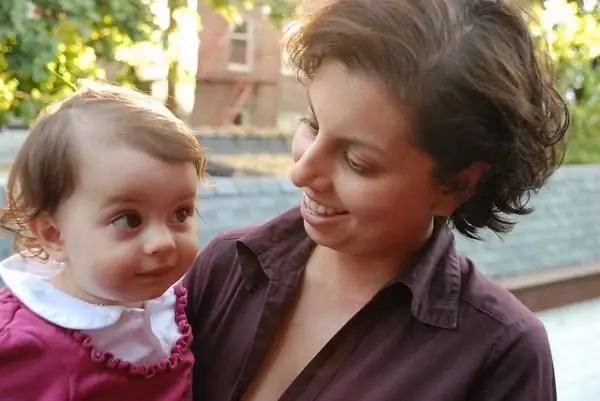2025 Author: Priscilla Miln | [email protected]. Last modified: 2025-01-22 17:55:18
What can the iodophilic flora in the feces of a child mean? What disease does it indicate? Should medications be used for treatment? You can try to figure it out.
What is this flora?
Iodophilic flora in feces appears when the number of lactobacilli and bifidobacteria decreases and they are replaced by a variety of pathogenic or conditionally pathogenic microorganisms:

- yeast cells;
- cocci;
- chopsticks;
- fusiform bacilli;
- Clostridia bacteria.
Clostridia can be introduced into normal cells of the environment or be in the intercellular space. In a "he althy" fecal analysis, such inclusions should not be.
Is it necessary to destroy the iodophilic flora?
Iodophilic flora in a child's stool does not necessarily indicate any serious illness. It is almost impossible to assume its presence in the intestines, despite the fact that the baby has a normal temperature, he eats well, is cheerful, sleeps peacefully. Without taking tests, it is impossible to guess about problems with the intestinal flora.

Individual diarrhea or excessive gas may be due to excess fiber in the diet. If there is no reason to worry, but a stool test was passed, in which the iodophilic flora was found, then we can assume that this is the norm for this baby.
But you need to remember that the flora is conditionally pathogenic, and in favorable conditions for itself (in violation of the food regimen, for example), it can manifest itself.
When is opportunistic flora present in the gut?
Iodophilic flora in the feces of a child can be detected if the diet has changed, and the baby began to receive more carbohydrates. At the same time, the movement of food through the intestines slows down, and fermentation processes may occur. An excess of fruit in the diet in some cases causes putrefactive dyspepsia.
Treatment when introducing new products is not required. Gradually, the right bacteria will populate the intestines, and pathogenic microorganisms will recede.
Children who are naturally weak, have low immunity or have been under the influence of chemotherapy will not be able to cope with the disease on their own. They are prescribed probiotics.
Iodophilic flora in the feces of a child may be present if he has:

- disturbed digestion in the stomach itself or in the upper digestive tract;
- accelerated movement of food through the intestines;
- nutrients are not actively absorbed in the small intestine;
- pancreas pathology available.
Concentrationsuch inclusions can be found within the appendix in its iliac part.
Detection of iodophilic flora
Visually examining the child's feces, it is impossible to identify conditionally pathogenic flora. Iodophilic flora is detected in the coprogram, a special analysis of feces.
In order to get a reliable test result, which the doctor will confidently rely on when making a diagnosis, the feces must be fresh. In yesterday's feces, iodophilic flora cannot be detected due to the property of starch to hydrolyze.
By the way, the flora got its name - iodophilic - precisely because of the reaction to iodine. When staining a laboratory sample with iodine, clostridia are partially stained, cocci, pathogenic bacteria and yeasts become dark blue and black.
What is a coprogram and how is it taken?
Since the iodophilic flora is determined by the coprogram, we should dwell on this analysis in more detail.

This is an objective study that can tell about the work of the digestive system. The child's stool is examined visually and by chemical composition, the presence of bacteria and microorganisms is determined in it.
During the coprogram, feces are visually described for density, structural uniformity and color, examined under a microscope, they are affected by special substances.
Microscopic examination tells about the work of the digestive organs and the secretion of bile. It is informative for the detection of dysbacteriosis and oncologicaldiseases. Only a coprogram can detect hidden blood in the feces. Fermentative or putrefactive dyspepsia, which is caused by iodophilic flora, is also detected using this study.
Iodophilic flora should be fought. The presence of pathogenic microorganisms in the children's intestines can lead to the development of chronic colitis and disruption of the gastrointestinal tract as a whole.
Recommended:
A child of 3 years old does not obey: what to do, the psychology of the child's behavior, the causes of disobedience, advice from child psychologists and psychiatrists

It is quite a common situation when a child of 3 years old does not obey. What to do in this case, not all parents know. Many of them try to calm the child with persuasion, shouting and even physical impact. Some adults just go on about the baby. Both of them make mistakes. Why does a three-year-old child not obey and how to stop it? This post will answer these questions
Dry skin in a child. Dry skin in a child - causes. Why does a child have dry skin?

The condition of a person's skin can tell a lot. Most of the diseases known to us have certain manifestations on the skin in the list of symptoms. Parents should pay attention to any changes, whether it is dry skin in a child, redness or peeling
Child does not want to learn: advice from a psychologist. What to do if the child does not want to study

Sending their inquisitive kids to school, many parents do not even suspect what difficulties they will face in the near future. The pedagogical practice of recent years shows that the number of children who do not gravitate towards learning is growing rapidly from year to year
A 2-year-old child does not speak. What time do children start talking? When does the child say the first word?

What to do if a child does not speak at 2 years old? How to react to parents? Are there teaching methods aimed at developing speech? Which specialists to contact? Read about it in our article
Child does not study well - what to do? How to help a child if he does not study well? How to teach a child to learn

School years are, without any doubt, a very important stage in the life of every person, but at the same time quite difficult. Only a small part of children is able to bring home only excellent grades for the entire period of their stay in the walls of an educational institution

